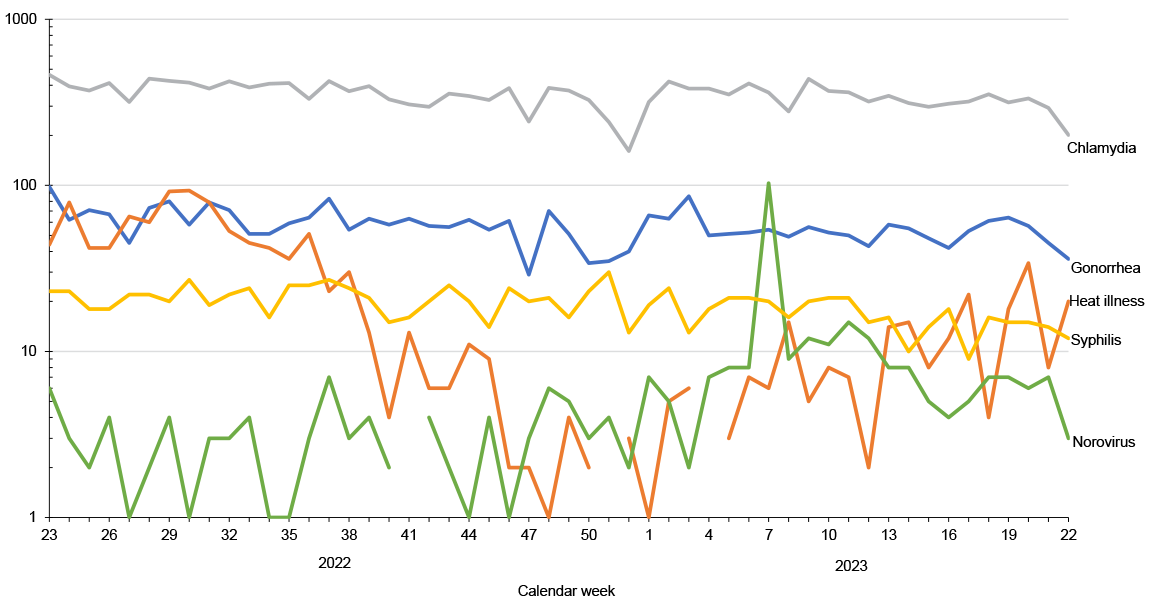Reportable Medical Events, Military Health System Facilities, Week 22, Ending June 3, 2023
 Graph depicting the frequency of the five most common reportable medical events within the Military Health System over the preceding year.
Graph depicting the frequency of the five most common reportable medical events within the Military Health System over the preceding year.
Reportable Medical Events are documented in the Disease Reporting System internet by health care providers and public health officials across the Military Health System for the purpose of monitoring, controlling, and preventing the occurrence and spread of diseases of public health interest or readiness importance. These reports are reviewed by each service’s public health surveillance hub. The DRSi collects reports on over 70 different RMEs, including infectious and non-infectious conditions, outbreak reports, STI risk surveys, and tuberculosis contact investigation reports. A complete list of RMEs is available in the 2022 Armed Forces Reportable Medical Events Guidelines and Case Definitions.1 Data reported in these tables are considered provisional and do not represent conclusive evidence until case reports are fully validated.

Total active component cases reported per week are displayed for the top five RMEs for the previous year. Each month, the graph is updated with the top five RMEs, and is presented with the current month’s (May 2023) top five RMEs, which may differ from previous months. COVID-19 is excluded from these graphs due to changes in reporting/case definition updates in 2023.

References
- Armed Forces Health Surveillance Division. Armed Forces Reportable Medical Events. Accessed April 6, 2023. https://www.health.mil/Military-Health-Topics/Health-Readiness/AFHSD/Reports-and-Publications/Armed-Forces-Reportable-Medical-Events
- Defense Manpower Data Center. Department of Defense Active Duty Military Personnel by Rank/Grade of Service, October 31, 2022. https://dwp.dmdc.osd.mil/dwp/app/dod-data-reports/workforce-reports
- Defense Manpower Data Center. Armed Forces Strength Figures for January 31, 2023. https://dwp.dmdc.osd.mil/dwp/app/dod-data-reports/workforce-reports
- Navy Medicine. Surveillance and Reporting Tools–DRSI: Disease Reporting System Internet. https://www.med.navy.mil/Navy-Marine-Corps-Public-Health-Center/Preventive-Medicine/Program-and-Policy-Support/Disease-Surveillance/DRSI
You also may be interested in...
Article
Jun 30, 2022
“Prior to the attack, teams were preparing to leave the area. Suddenly, everything changed, and our main goal shifted from COVID-19 support to blood supply and triage.”
Article
Jun 24, 2022
To help counter that stigma of being "broken", the 10th Division Sustainment Troops Battalion “Workhorse,” 10th Mountain Division Sustainment Brigade, and the brigade’s Holistic Health and Fitness team, also known as H2F, joined forces to create the Unbreakable Warrior program, also known as UBW.
Article
Jun 23, 2022
Emerging technology may use drones to deliver blood products for wounded troops on the front lines of combat. That capability may be critical in a "near-peer" conflict.
Article
Jun 23, 2022
Brooke Army Medical Center commissioned a new, four-legged staff member with a penchant for spreading joy to the rank of United States Army major during a ceremony June 6.
Article
Jun 21, 2022
A team of scientists and engineers from the U.S. Army Public Health Center and the Navy and Marine Corps Public Health Center recently traveled to Fort Carson to conduct a Joint Service Member Occupational Health Assessment, also known as a JSOHA, of the M777 Howitzer—a weapon that is routinely used in military training and combat operations.
Article
Jun 21, 2022
Ensuring proper training of both providers and patients is essential for the successful integration and sustainment of MHS GENESIS into MHS care.
Article
Jun 17, 2022
Army Maj. Rebeccah Dindinger serves as a Clinical Nurse Specialists at Landstuhl Regional Medical Center in Germany.
Photo
Jun 14, 2022
Aviation Ordnanceman 3rd Class Dominique Campbell drives a forklift on the flight deck of the Nimitz-class aircraft carrier USS Harry S. Truman (CVN 75) during a vertical replenishment. She is wearing proper hearing and vision protection.
Article
Jun 13, 2022
As part of the U.S. Southern Command’s enduring partnership to Central America, Joint Task Force-Bravo executed a three-day Global Health Engagement in Comayagua, Honduras, June 1-3, working side by side with local military and Ministry of Health personnel.
Article
Jun 10, 2022
The San Antonio Market offers a group obstetric model for pregnant women at Brooke Army Medical Center.
Article
Jun 9, 2022
Medics at David Grant USAF Medical Center on Travis Air Force Base, California, are being trained monthly during a week-long course on tactical combat casualty care in an Air Force-wide initiative to standardize medical readiness training for all service members.
Article
Jun 8, 2022
As the Pentagon prepares today’s force for a “near-peer” fight against a large military adversary, the Military Health System is challenged to provide life-saving support for large-scale and dispersed operations. That’s especially true for the medics supporting troops on the front lines.
Article
Jun 3, 2022
This Army doctor finished at the top of his class at the Air Assault School at Fort Campbell. It's a 10-day course that is both physically and academically challenging, teaching soldiers the foundations of heliborne operations to include troop transportation, sling loaded cargo and equipment transportation, medical and casualty evacuation operations, ...
Article
Jun 2, 2022
Air Combat Command has tasked the 23rd Wing to be Lead-Wing ready in October of 2022 and medically preparing Airmen for a Lead-Wing deployment is no small feat.
Article
Jun 2, 2022
Moving can be hard on military families, especially on children. Moving to a new home, going to a new school, finding new friends – it can be unsettling for kids of any age. Yet, there are things that service members can do to prepare for a permanent change of station move that can make for a smoother transition for the children.
You are leaving Health.mil
The appearance of hyperlinks does not constitute endorsement by the Department of Defense of non-U.S. Government sites or the information, products, or services contained therein. Although the Defense Health Agency may or may not use these sites as additional distribution channels for Department of Defense information, it does not exercise editorial control over all of the information that you may find at these locations. Such links are provided consistent with the stated purpose of this website.
You are leaving Health.mil
View the external links disclaimer.
Last Updated: August 24, 2023